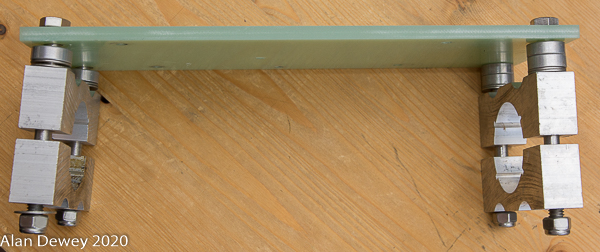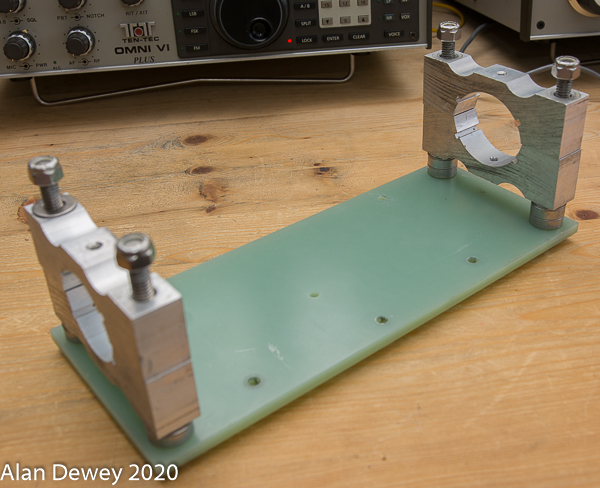Repairing a Steppir Biggir Vertical – part 6 – Rebuilding the EHU again – the final fix :-)

Update April 2021 I now believe that I know exactly what has caused these failures. It is NOT the manufacturer’s fault ! Jump to the ‘solution’ here https://blog.secondhandradio.com/2021/02/steppir-biggir-failed-again/ the first 6 articles in this series will remain here as an example of troubleshooting, analysis, and repair of this antenna.
This is part 6 of 6. You may want to start with part 1 here.
This part of the adventure covers my successful fix of the EHU (element housing unit.) In an earlier installment, we fixed the 80m coil, then spent a couple weeks of evenings and weekends ‘chasing my tail’ before learning that the second problem with the antenna was in the EHU, not the coil.
Keep in mind that I do not know what caused the failure of the 80m coil assembly. I have not been able to come to any conclusions about why the EHU failed and thus, why my fix is a fix. Nothing is completely clear to me. What I can say is that since I rebuilt the EHU I have never had a second of trouble with it since, even with operations at 1,500 watt.
In part 5 of this saga, I described my ‘fix’ for the EHU, and then described the manner in which my ‘fix’ failed terribly.
OK, the physical part of my ‘fix’ was a failure, but it did provide more education which has led to a ‘permanent’ fix. “Permanent” in that I have been operating 1,500 W to the Steppir Biggir with 80m coil accessory for more than 4 weeks now… and it is still operating beautifuly.
The ‘final fix’ involved these ‘final’ changes:
- Remove the o-ring from the BeCu ribbon guide
- Change mounting mast material
- Remove the HWK (high wind kit)
An earlier installment of this story showed that the o-ring was useless. I also infer from all of this that there was no ‘water intrusion.’ If there is significant condensation within the mast, then the water should be able to run out the bottom of the antenna assembly. So although removing the o-ring might not have contributed to the ‘final fix’, it did make the repair simpler. By not bothering with the o-ring, it means that non-machinists like me can more easily make a replacement BeCu ribbon guide since we do not need a groove for the o-ring.
Since the first installation of the Steppir Biggir vertical in early 2019, it was mounted on a galvanzed steel pipe, which of course was grounded. Not knowing the exact failure mechanism, for further likelyhood of success, I chose to reduce the possibility of arcing to grounded mast, I elminated the metal mast and used Noryl PPO solid rod (McMaster-Carr #8580K18). Here is what McMaster Carr us about Noryl PPO:
- Color: Black
- Temperature Range: -40° to 220° F
- Tensile Strength: 9,200 psi (Good)
- Impact Strength: 3.5 ft.-lbs./in. (Good)
- Hardness: Rockwell R119 (Hard)
- For Use Outdoors: Yes
- Specifications Met: See table
- Dielectric Strength: 500 V / mil
Often used for electrical insulating applications where moisture is a concern, these Noryl PPO rods absorb very little water and remain dimensionally stable, even when temperatures fluctuate.
They probably mean 500 volt / millinch (all the other specifications are in American units) so we only need 10 millinch to insulate our 5 kV on the BeCu ribbon.

The Noryl PPO mounting mast is the black rod in the image above. It fit perfectly where I had previously used a galvanized steel pipe for a mast.
This material seems to be very strong… I suppose you could use it for a baseball bat.
DO NOT INSTALL THE HIGH WIND KIT !

Looking through my notebook I learned that all my troubles can be separated by a point in time. That point in time was installation of the High Wind Kit (HWK). When the Steppir Biggir with 80m coil was installed in late March 2019, I did NOT install the HWK. Steppir clearly states that if you have the 80m coil option installed and you intend to run high power, that you should NOT install the HWK. At that time, the main plate of the HWK was aluminum. Now Steppir offers a fiberglass substitute for the HWK.
I operated many contests and ragchews with an amplifier and did not have any problem at all until that surprise one evening in March. As I said in part 1, I do not know what caused that failure, but I will chalk it up to some mistake I made with the new-to-me amplifier.
At that time I had damage ONLY to the 80m coil accessory, which I then repaired.
The 80m coil accessory was repaired, reinstalled onto the vertical along with the HWK.
Then all the trouble in the EHU started. I rebuilt it, if failed again. I rebuilt it again, it failed again.

I rebuilt the EHU one more time, but I did NOT install the HWK, changed the mast to Noryl PPO, and now have a 80-10m vertical that operates happily with 1,500 W.
So is the key to the fix the Noryl PPO ‘mast’ or just not using the HWK ?
The fiberglass tube is 3mm thick (1/8 inch) and did not fail for the first 10 or 11 months of use with the metal mast. Fiberglass tube has a high dielectric strength. So, to me, the amount of benefit of the Noryl PPO rod is unknown.
Could it be solely the fault of the HWK ? That is a real head-scratcher. The only metal parts of the HWK are the clamps. One clamp above the EHU and one clamp below the EHU. They are pretty far from any conductors that have HV RF on them.
Could it be capacitance between the lower HWK clamp and the metal mast at the base? I don’t see how. I can imagine that it could lead to breakdown on the outside of the fiberglass tube…. but look at the strange path of the burning between the BeCu and the metal mast. Also, I do not see how that would cause a breakdown of the Delrin insert.
I do not know the permittivity of the fiberglass plate in the HWK. Is it even a realistic question that the RF in the vertical mast above the EHU coupled to the upper HWK clamp, and it capacitively coupled to the lower HWK clamp that coupled to the metal mast? ? And a few more ?????? But again, my brain can not begin to relate that hypothesis to the shape of the breakdown of the fiberglass tube or the Delrin BeCu ribbon guide.
UPDATE: The antenna failed again on February 5, 2021. Click here for that story.
Comments?

